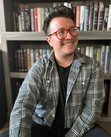Gabe Cole Novoa's Blog, page 56
August 11, 2015
Vlog: All About BEYOND THE RED (Part 2)
In honor of Beyond the Red's cover reveal, I'm (still!) answering questions all about the book! Yay!
This week's questions are mostly about the publication/writing process behind the book. Hope you guys enjoy!
RELATED LINKS:
Enter to win a signed ARC and bookmark (US Only)! Goodreads (where you can add my book to your TBR shelf)!Beyond the Red pre-order links (where you can buy my book)!From Contest to Book Deal (vlog)All About Beyond the Red (Part 1) (vlog)Pinterest mood board for Beyond the Red
Twitter-sized bite:





This week's questions are mostly about the publication/writing process behind the book. Hope you guys enjoy!
RELATED LINKS:
Enter to win a signed ARC and bookmark (US Only)! Goodreads (where you can add my book to your TBR shelf)!Beyond the Red pre-order links (where you can buy my book)!From Contest to Book Deal (vlog)All About Beyond the Red (Part 1) (vlog)Pinterest mood board for Beyond the Red
Twitter-sized bite:
Curious about the writing/publication process behind a book? @Ava_Jae answers questions all about it. #vlog (Click to tweet)





Published on August 11, 2015 04:00
August 10, 2015
Books Written Before Debuts: Stats
 Photo credit: kenteegardin on FlickrSo a little while ago, while I was looking for statistics about the number of books various authors had written before writing their debuts, I found that there was shockingly little information out there. I mean, sure, if you hunted for it you’d find some scattered answers, but I couldn't find an easy database with averaged information.
Photo credit: kenteegardin on FlickrSo a little while ago, while I was looking for statistics about the number of books various authors had written before writing their debuts, I found that there was shockingly little information out there. I mean, sure, if you hunted for it you’d find some scattered answers, but I couldn't find an easy database with averaged information.So I asked around Twitter to see if anyone knew of such a database. And no one did. But the genius @Bibliogato suggested I take an unofficial Twitter poll and hope it got RTed enough to get some decent data.
So I did. And wow, did it ever get enough RTs.
Overall, I got over 200 responses from traditionally published writers all over Twitter, which was pretty incredible. Combined with some data I found online from specific authors, it gave me a pretty interesting spread of information.
The question I asked specifically, was how many novels the respondents had written before writing their debut novel.
83.8% of respondents said that they’d written at least one novel before writing their debut. The most common answer was one (so debut was the second book), followed very closely by three (debut was fourth). The average was 3.24 books written before debuting.
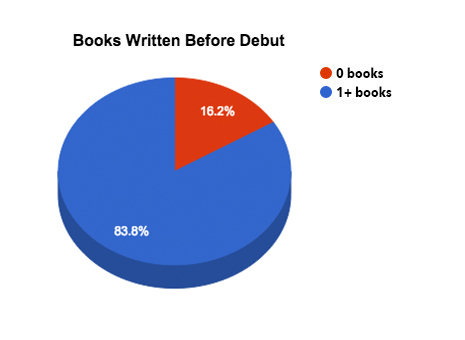 16.2% debuted with their first novel. 17.1% debuted with their second novel. 13.1% debuted with their third novel. 16.7% debuted with their fourth novel. 14% debuted with their fifth novel. 7.7% debuted with their sixth novel. 6.2% debuted with their seventh novel.9% write seven or more books before writing their debuts.
16.2% debuted with their first novel. 17.1% debuted with their second novel. 13.1% debuted with their third novel. 16.7% debuted with their fourth novel. 14% debuted with their fifth novel. 7.7% debuted with their sixth novel. 6.2% debuted with their seventh novel.9% write seven or more books before writing their debuts. 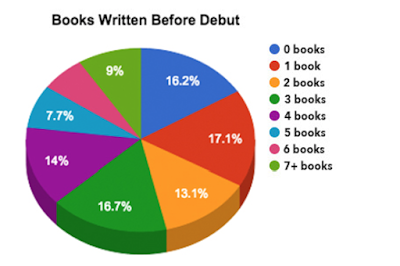
The spread:
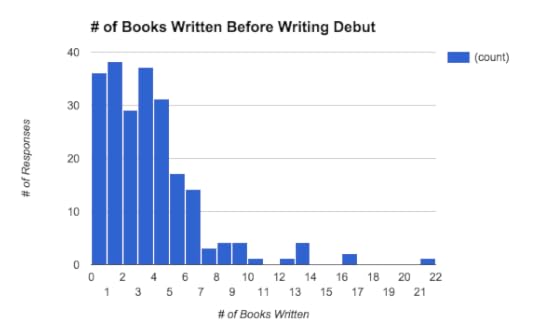
That data point of 20+ books written before debuting? That’s a HUGE author. Like, Twitter-verified, NYT bestseller. AKA: don’t give up.
Some interesting anecdotes:
One writer spent 17 years writing short stories before writing their debut. One writer wrote over 40 novellas before writing their debut.One writer spent 10 years writing fan fiction before writing their debut. One writer spent 25 years writing four books. One writer spent 13 years writing one book (their debut). Many writers didn’t sell the first book they signed an agent with.
All in all, there was a really wide spread here, but I think the takeaway is not to give up. Maybe it’ll only take you one book, and maybe it’ll take you twenty. But if you keep working at it, and writing, and revising, and sending your book out there—one way or another, I think you’ll make it.
What do you think of the statistics?
Twitter-sized bites:
.@Ava_Jae asked pubbed writers on Twitter how many books they wrote before writing their debuts. Here are her stats. (Click to tweet)
Writer @Ava_Jae shares her results from her unofficial Twitter poll on how many books pubbed writers wrote before their debuts. (Click to tweet)
Feeling discouraged about having to trunk a novel? @Ava_Jae shares statistics you might find encouraging. (Click to tweet)





Published on August 10, 2015 04:00
August 7, 2015
Top Writability Resources for Your Writing Needs
 Photo credit: DeaPeaJay on FlickrSo over the course of about fifty-one months, Writability has accumulated over 750 posts. Which is, um, a lot. And while the directory has almost all of them (I try to do my best to keep it updated), I am well aware that scrolling through 750 blog posts can be a teensie bit overwhelming. Kind of like hoping for enough snow for a white Christmas and getting seven feet instead (too soon, Buffalo?).
Photo credit: DeaPeaJay on FlickrSo over the course of about fifty-one months, Writability has accumulated over 750 posts. Which is, um, a lot. And while the directory has almost all of them (I try to do my best to keep it updated), I am well aware that scrolling through 750 blog posts can be a teensie bit overwhelming. Kind of like hoping for enough snow for a white Christmas and getting seven feet instead (too soon, Buffalo?).Ehem. Anyway.
I thought it might be helpful to highlight some posts for you guys, depending on your specific writing needs. So here we go.
Brainstorming & Plotting
Are you a plotter or a pantser? There isn’t a right or wrong answer, but assuming you're a plotter, once you have an idea you’d like to explore, it’s time to turn that idea into a plot. One option is to try writing a synopsis before the first draft—which is less terrifying that it sounds (I know! I was surprised too). Otherwise, I vlogged about how I plot my WIPs, and before that I blogged about it. You may also want to check out Scrivener’s cork board, which I love forever for plotting and brainstorming.
Not sure what plot points you hit? I haven’t covered them all (yet!) but here are some plot essentials you want to make sure you include.
If you’re not a plotter but you still want something to work off of, you may want to try plotting without plotting (not a typo!).
First Drafting
Eventually! It’ll be time to dive into your first draft. Remember that you don’t have to know everything before you start drafting, whether you’re a plotter or pantser. Also good to keep in mind that usually, the first draft sucks (really, but it's okay), and you don’t have to get it right the first time. Not even close.
If you want to get through your first draft quickly, you may want to try fast-drafting. And while you don’t have to think too hard about getting things right when first drafting, you may find it helpful to think about how to write strong supporting characters and awesome face-smooshing—excuse me, kissing—scenes.
Revision/Editing
So you’ve written your first draft! YAY! Before you dive into editing, you’ll want to let your manuscript cool a little so that you can read your writing a little more objectively.
But then the time will come to dive into your manuscript again! Which can be a little scary, but not to fear—here are some tips on how not to get overwhelmed with revisions. Remember not to be afraid to make big changes, and while you’re at it here’s how to use what ifs while revising and how to use brainstorming to edit.
When you reach the time to line edit, don’t forget to hunt down those filter phrases.
You’ll also need critique partners in this stage (and remember—critiquing others helps you, too!). If you don’t have any, here are five places to find critique partners, and how to choose the right CPs.
Finally, if you have Scrivener for Mac and you like pretty colors and seeing the changes you’ve made, here’s how to use Scrivener’s version of track changes.
Querying
So you’ve polished your manuscript to a beautiful gleam with the help of critique partners! Yay! Now, assuming you want to get traditionally published, is time to prepare to query agents. First thing you’ll want to do is finally get the dreaded synopsis out of the way (I know, I know).
Next you’ll want to think about what genre and category your novel is in before you start researching agents so you know who to target. Now sure where to start? Here’s how to determine your WIP’s genre—and the vlog version if you prefer. (Hint: YA is not a genre) and here’s part one and part two of my basic genre index, for an overview.
Know how to categorize your novel? Have your synopsis ready? Awesome. Time to start researching agents—and here are extra researching resources. While you’re researching, here are some red flags to look out for. Ultimately, not every agent will be the right agent for you, so here are some tips on choosing the right agent for you.
Now some tough love: you’re going to get rejected. A lot. And even after you get agented and published, rejection doesn’t stop. But here are some tips to help you get through the query wars, and here are some encouraging stats for the querying writer. Ultimately, I think hope is the best remedy for rejection, so try to remember this is just part of the process and all writers go through it.
And finally, if it ever starts to feel like too much and you’re thinking about giving up on your writing dream altogether, please read this first.
Did I miss any resources you especially like? What tips would you add to the roundup?
Twitter-sized bite:
Looking for writerly resources and pub tips? @Ava_Jae rounds up helpful posts for every stage of the writing process. (Click to tweet)





Published on August 07, 2015 04:00
August 5, 2015
Pub Life: Starting to Feel Real
So last week, as many of you know, YA Books Central revealed Beyond the Red’s cover. Shortly before that Red was listed online at B&N, Amazon, BAM!, IndieBound and more, and is now available for pre-order.
On Sunday, I had my author photos taken. And on Monday, these came in:
On Sunday, I had my author photos taken. And on Monday, these came in:
OMG OMG THEY'RE HERE. The swag! I have it.
Published on August 05, 2015 04:00
August 4, 2015
Vlog: All About BEYOND THE RED (Part One)
In honor of Beyond the Red's cover reveal, I'm answering questions all about the book! Yay!
If you have questions about the publication/writing process behind the book, let me know and I'll answer them in next week's vlog. :)
RELATED LINKS:
Enter to win a signed ARC and bookmark (US Only)Goodreads (where you can add my book to your TBR shelf)!Beyond the Red pre-order links (where you can buy my book)!From Contest to Book Deal (vlog)Original publication announcement
Do you have any questions about the book or the writing/publishing process behind it?
Twitter-sized bite:





If you have questions about the publication/writing process behind the book, let me know and I'll answer them in next week's vlog. :)
RELATED LINKS:
Enter to win a signed ARC and bookmark (US Only)Goodreads (where you can add my book to your TBR shelf)!Beyond the Red pre-order links (where you can buy my book)!From Contest to Book Deal (vlog)Original publication announcement
Do you have any questions about the book or the writing/publishing process behind it?
Twitter-sized bite:
Like aliens, technology, kissing, explosions, culture clashes & monarchies? @Ava_Jae vlogs about her YA SF debut BEYOND THE RED. (Click to tweet)





Published on August 04, 2015 04:22
August 3, 2015
Platform Building for Beginners: Where to Start?
 Photo credit: the tartanpodcast on FlickrSo someone asked me recently if I had a post on platform building in general for beginners, and I sort of have a couple specific platform posts, but not a general one, so here we go. Platform building.
Photo credit: the tartanpodcast on FlickrSo someone asked me recently if I had a post on platform building in general for beginners, and I sort of have a couple specific platform posts, but not a general one, so here we go. Platform building.While I still consider myself someone who is learning and growing my platform as a debut author, I have learned quite a bit about growing your social media sites over the last many years, and so here are my top five tips.
The earlier you start, the better. Ultimately, building a platform takes time—and a lot of it. No matter what platform you use, getting noticed, making connections and getting followers/subscribers is a long game. I requires a slow build up of steadily shared content and reaching out to other people.
I started my Twitter and blog—which is where I have the biggest following—over four years ago. To give you an idea:
May 2011: 447 monthly page views
May 2012: 13,292 monthly page views
May 2013: 31,544 monthly page views
May 2014: 29,727 monthly page views (stats rise and fall!)
May 2015: 33,536 monthly page views
Biggest traffic month ever: October 2014 (43,347 page views in a month)
So as you can see, it took two years to really get steady traffic going. It’s totally fine, of course, if you don’t have two years to get engagement going, but just don’t expect your follower count to explode overnight.
Stick with platforms you actually enjoy. I’m all over the internet—this blog, Twitter, tumblr, Facebook, Instagram, YouTube. But! You definitely don’t need to use all of those platforms if you don’t want to. Instead, I recommend you stick with platforms you actually enjoy using (though if you’re like me and you enjoy using all of them…more power to you)—your interactions will feel more natural and your followers will notice. Plus, keeping them updated won’t feel like such a chore.
Connect with other people. Ultimately, the whole point of having a platform is getting to know other people and making connections. The more you reach out and engage, the more connected your followers will feel. Be yourself and show them you’re a person—not a sales robot.
Consistency is everything. No matter what platform you use, the key is always always consistency. The only way to develop a steady buildup of followers is to continue creating and sharing content. Depending on what platform you use, “consistent” doesn’t necessarily have to mean every day—but the more you share and create, the more engagement you’ll get. That said…
Don’t become a spambot. This is the biggest turnoff for readers and followers of every kind, on every platform. No one wants to see a feed where the only thing shared is about the person’s book. You want to market your books, obviously, but that should never be the bulk of the content you share. Share other people’s stuff, talk to people, create content about something other than your book that your followers enjoy, that way when you do talk about your book it won’t feel forced or overdone.
BONUS: Cross-post! Assuming you have more than one social media account, the best way to take full advantage of your many social media sites is to cross-post the things you share. Granted, you want to do this carefully—and you don't want to cross-post everything. But if you have a blog post, share it on your Twitter and tumblr! Have a vlog? Put it on your blog and Facebook! Have an Instagram account? Share your photos on Twitter! This not only helps boost your output on all sites and get what you share out to more people, but it also helps people who follow you on one channel reach out to you on another. Win-win!
What tips do you have for platform building?
Twitter-sized bite:
Not sure how to start building your social media platform? @Ava_Jae shares her top tips. (Click to tweet)





Published on August 03, 2015 04:00
August 1, 2015
On Writing a Series by Vicki Leigh + Cover Fun!
NOTE: Hey guys! Today I've got a super special (and rare) Saturday post to share with you the super epically awesome cover for my CP Vicki Leigh's second novel Find Me if You Dare! And because she's awesome, she's also chatting with us about what it's been like to write a series. AND there's a giveaway. Woot!
Enjoy!
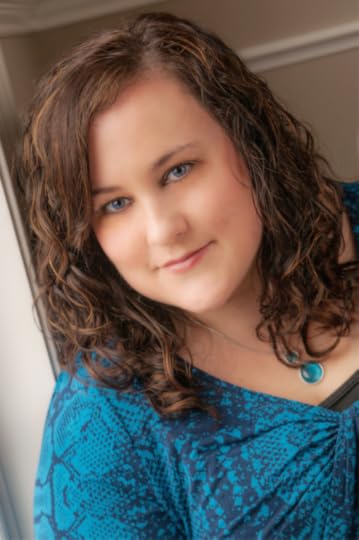
As a reader, I love series. Not only does it give me a chance to stay in the world I’ve come to know, but it gives me the opportunity to hang out with the characters I’ve come to adore, too. So, when I first started writing with the intent to be published, there was one goal that I knew I had to achieve: publish a series.
I’m so excited to announce: Book Two of my Dreamcatcher series is releasing December 1, 2015! The excitement is insane, ya’ll.
But while there was lots of squealing and jumping for joy when I got the contract for the second book, I realized I had no idea how to actually write a series. I understood how to start a story and complete a story arc, but how do you take a story arc and expand on it so that the next book has its own arc but both books are encompassed under a bigger story arc umbrella?
Cue a mini panic attack, am I right?
Well, after a few mishaps and re-drafting the same scenes multiple times, I learned a few things about writing a series—and I want to share them with you!
Have your ultimate end in sight. It’s one thing to worry about the ending of a book, but I think it’s even more important to have the series’ climax planned ahead of time. If you know how you want to series to end, you can then work backward to figure out where each book in the series should end.
For example, as the blurb for Find Me If You Dare tells you, the four Horsemen of the Apocalypse have a significant role to play in my Dreamcatcher series. I then made a clear distinction as to how I would reach that final ending: two Horsemen would ride in Book Two, and the others would (maybe) ride in Book Three. Right there, I had a clear idea of where my plot was heading and how I would ensure my series arc continued over the rest of my books—and all because I knew how I wanted my series to end.
Force yourself to plot, even just a little bit. I know many of you are “pantsers,” and you let your characters dictate what happens in your stories. That’s perfectly fine! I am not telling you to become a “plotter.” In fact, I like to think of my self as a “plotser” because I’m not one of those people who use scene cards or outline from beginning to end. But I still make sure I have some sort of backbone so I don’t lose track of my story arc.
In my opinion, this is even more important when it comes to writing series. Each book needs to connect to tell one big story, and if you’re simply starting at page one with no idea of what’s going to happen, you will find yourself spending a lot of time in revision, trying to put all the puzzle pieces together. So, even something as simple as Dan Wells’ 7 Point Plot can help make sure you’re moving each book in the right direction toward that ultimate, series end.
Re-read the other books in your series before you start writing the next one. Maybe you guys are already awesome and can jump right into characters’ voices, even though you’ve had zero contact with them for a while. But if you’re like me, and you fully absorb yourself into each new point of view you write, it’s really hard to jump back into an old character’s head. To make sure you’re getting the voice right—and the tone right—the best thing you can do for yourself is to read the first book(s) in your series. Besides, what’s more fun that falling back in love with the characters you haven’t “seen” for a while?
Find a critique partner or beta reader you trust and talk it out with them—if they don’t mind spoilers! One of the great things about my best friend and CP (though she has many) is that she lets me talk out my plot ideas and isn’t afraid to offer advice about where I might be steering the story wrong. Having someone to brainstorm with can make a huge difference because their opinions can absolutely spark new ideas that you never would’ve come up with on your own.
Finally, if you are struggling to determine where your story should go, do some exercises from your main character(s) point of view. Act out a scene as if you were that character. Write journal entries as if you were that character. Actually talk to them if you have to. It’s amazing what can happen if you put yourself in the place of your character and start to think about the story in other ways than plot points on pages. Becoming a character can make a story feel real, and when you’re in “the zone,” many ideas can spark.
And now, for the cover. Ready?
...
...
...
...
...
...
...
BAM
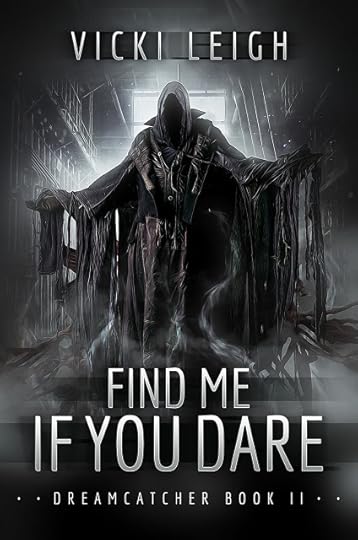
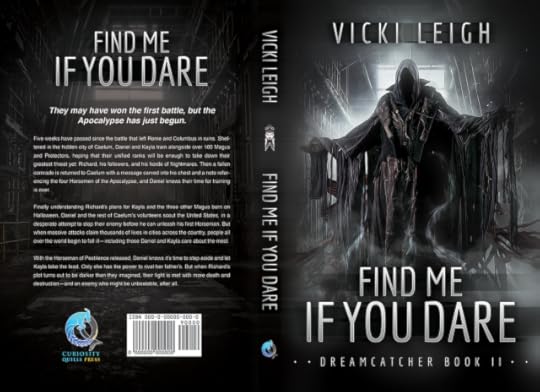
Isn't it friggin' amazing? Here's what it's about:
Finally, there's a 22 book giveaway over on her tumblr page, so if free books and swag are something you're into, you may want to check that out. :)
Enjoy the rest of your weekend!
What do you think of the post and cover?
Twitter-sized bites:





Enjoy!

As a reader, I love series. Not only does it give me a chance to stay in the world I’ve come to know, but it gives me the opportunity to hang out with the characters I’ve come to adore, too. So, when I first started writing with the intent to be published, there was one goal that I knew I had to achieve: publish a series.
I’m so excited to announce: Book Two of my Dreamcatcher series is releasing December 1, 2015! The excitement is insane, ya’ll.
But while there was lots of squealing and jumping for joy when I got the contract for the second book, I realized I had no idea how to actually write a series. I understood how to start a story and complete a story arc, but how do you take a story arc and expand on it so that the next book has its own arc but both books are encompassed under a bigger story arc umbrella?
Cue a mini panic attack, am I right?
Well, after a few mishaps and re-drafting the same scenes multiple times, I learned a few things about writing a series—and I want to share them with you!
Have your ultimate end in sight. It’s one thing to worry about the ending of a book, but I think it’s even more important to have the series’ climax planned ahead of time. If you know how you want to series to end, you can then work backward to figure out where each book in the series should end.
For example, as the blurb for Find Me If You Dare tells you, the four Horsemen of the Apocalypse have a significant role to play in my Dreamcatcher series. I then made a clear distinction as to how I would reach that final ending: two Horsemen would ride in Book Two, and the others would (maybe) ride in Book Three. Right there, I had a clear idea of where my plot was heading and how I would ensure my series arc continued over the rest of my books—and all because I knew how I wanted my series to end.
Force yourself to plot, even just a little bit. I know many of you are “pantsers,” and you let your characters dictate what happens in your stories. That’s perfectly fine! I am not telling you to become a “plotter.” In fact, I like to think of my self as a “plotser” because I’m not one of those people who use scene cards or outline from beginning to end. But I still make sure I have some sort of backbone so I don’t lose track of my story arc.
In my opinion, this is even more important when it comes to writing series. Each book needs to connect to tell one big story, and if you’re simply starting at page one with no idea of what’s going to happen, you will find yourself spending a lot of time in revision, trying to put all the puzzle pieces together. So, even something as simple as Dan Wells’ 7 Point Plot can help make sure you’re moving each book in the right direction toward that ultimate, series end.
Re-read the other books in your series before you start writing the next one. Maybe you guys are already awesome and can jump right into characters’ voices, even though you’ve had zero contact with them for a while. But if you’re like me, and you fully absorb yourself into each new point of view you write, it’s really hard to jump back into an old character’s head. To make sure you’re getting the voice right—and the tone right—the best thing you can do for yourself is to read the first book(s) in your series. Besides, what’s more fun that falling back in love with the characters you haven’t “seen” for a while?
Find a critique partner or beta reader you trust and talk it out with them—if they don’t mind spoilers! One of the great things about my best friend and CP (though she has many) is that she lets me talk out my plot ideas and isn’t afraid to offer advice about where I might be steering the story wrong. Having someone to brainstorm with can make a huge difference because their opinions can absolutely spark new ideas that you never would’ve come up with on your own.
Finally, if you are struggling to determine where your story should go, do some exercises from your main character(s) point of view. Act out a scene as if you were that character. Write journal entries as if you were that character. Actually talk to them if you have to. It’s amazing what can happen if you put yourself in the place of your character and start to think about the story in other ways than plot points on pages. Becoming a character can make a story feel real, and when you’re in “the zone,” many ideas can spark.
And now, for the cover. Ready?
...
...
...
...
...
...
...
BAM


Isn't it friggin' amazing? Here's what it's about:
They may have won the first battle, but the Apocalypse has just begun.
Five weeks have passed since the battle that left Rome and Columbus in ruins. Sheltered in the hidden city of Caelum, Daniel and Kayla train alongside over one hundred Magus and Protectors, hoping that their unified ranks will be enough to take down their greatest threat yet: Richard, his followers, and his horde of Nightmares. Then a fallen comrade is returned to Caelum with a message carved into his chest and a note referencing the four Horsemen of the Apocalypse, and Daniel knows their time for training is over.
Finally understanding Richard’s plans for Kayla and the three other Magus born on Halloween, Daniel and the rest of Caelum’s volunteers scout the U.S. in a desperate attempt to stop their enemy before he can unleash his first Horseman. But when massive attacks claim thousands of lives, people all over the world begin to fall ill—including those Daniel and Kayla care about the most.
With the Horseman of Pestilence released, Daniel knows it’s time to step aside and let Kayla take the lead. Only she has the power to rival her father’s. But when Richard’s plot turns out to be darker than they imagined, their fight is met with more death and destruction—and an enemy who might be unbeatable, after all.
Finally, there's a 22 book giveaway over on her tumblr page, so if free books and swag are something you're into, you may want to check that out. :)
Enjoy the rest of your weekend!
What do you think of the post and cover?
Twitter-sized bites:
How to write a series—@vleighwrites talks series-writing & shares the EPIC cover for her 2nd book. (Click to tweet).





Published on August 01, 2015 04:00
July 31, 2015
On Writing Through Everything
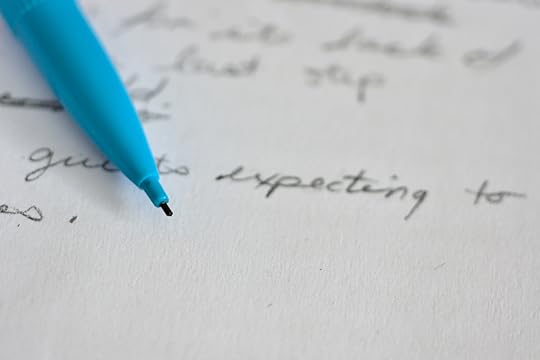 Photo credit: Bruce Guenter on FlickrNot too long ago, one of my lovely Twitter followers asked me how I made myself write through college in order to complete
Beyond the Red
. And I immediately knew it wasn’t an answer I was going to be able to fit in a tweet or two.
Photo credit: Bruce Guenter on FlickrNot too long ago, one of my lovely Twitter followers asked me how I made myself write through college in order to complete
Beyond the Red
. And I immediately knew it wasn’t an answer I was going to be able to fit in a tweet or two. So…I’ve mentioned this before, but I didn’t actually start writing with the intention of getting published in college. I started young. Like, pre-HS young. And I had pretty serious ambitions of getting published as a teen, but that didn’t happen, which is fine, but anyway.
The point is, for me, by the time I started college, I’d already developed a habit of writing. I wrote during all of my free time, I finished homework early so that I could write, I wrote during class—I was writing or thinking about writing all the time. So when I started college, it really wasn’t all that different.
For Beyond the Red specifically, I wrote it over a summer. If I remember correctly, I started just as my college semester ended, and drafted, revised, CPed, and revised again until I started querying in September.
Ultimately, I wasn’t, and I’m not, doing anything different from any other writer. All it comes down to is developing a habit and sticking to it.
The thing is, no matter when you start writing, there will always be other things that could take time away from writing. Homework, job work, kids, adult responsibilities, family issues, emergencies, health problems—the distractions and responsibilities that require time are just a part of life. If your aim is to write, and write professionally, you have to learn how to write even when you’re at your busiest. This means getting up early to write, or staying up late to write, or writing on your lunch break or instead of watching Netflix.
It also means writing when you don’t want to. And writing when you feel uninspired. And writing when you’re tired, or would rather be doing something—anything—else.
I’m not going to pretend it’s always easy, because it’s not. There are days where writing feels like dragging yourself through mud. But ultimately, if writing is your dream and telling stories is what you love, I think you’ll find that the good days and the end result are more than worth it.
But the only way to get there, of course, is to get your butt in a chair and write.
What do you think? How do you juggle writing with your other responsibilities?
Twitter-sized bites:
How do you juggle writing with your other responsibilities? Join the discussion on @Ava_Jae's blog. (Click to tweet)
.@Ava_Jae says if you want to write professionally, you'll need to write when you don't want to. What do you think? (Click to tweet)





Published on July 31, 2015 04:00
July 29, 2015
Writing Tip: Don’t Be Afraid of Said
 Photo credit: Kris Krug on FlickrNOTE: Today is the day! If you've been curious about Beyond the Red's cover, you need be curious no longer—the cover is NOW live on YA Books Central's blog! And I have it on good authority there miiiiight be something ARC-ish you guys can win. YAY!
Photo credit: Kris Krug on FlickrNOTE: Today is the day! If you've been curious about Beyond the Red's cover, you need be curious no longer—the cover is NOW live on YA Books Central's blog! And I have it on good authority there miiiiight be something ARC-ish you guys can win. YAY! So every once in a while I come across writers online who mention trying to avoid “said” in their writing. And I’m not 100% sure how this not-so-foolproof advice started, but I suspect it has to do with avoiding repetition in writing.
As I’m sure many of you know, a common critique in any sort of writing is the accidental repetition of certain words and phrases. Usually this comes through with writer ticks—everyone has a couple crutch words or phrases that they often unconsciously insert into their work while writing, and the ticks often even change manuscript to manuscript. That’s normal and easy to fix, and yes, should be adjusted particularly when it happens often enough to draw attention to itself.
“Said,” however, is not usually a word you have to worry about overusing. To a point.
When it comes to writing dialogue, "said" is a somewhat magical word because it’s largely invisible. The only time it really becomes noticeable is if too many dialogue tags are used, for example:
“Hello,” Mary said.You get the idea.
“Hello,” Bob said.
“How’ve you been?” Mary said.
“I’ve been great, and yourself?” Bob said.
“We’re using too many dialogue tags,” Mary said.
“I think you’re right,” Bob said.
Now, that’s not to say that you can’t (or shouldn’t) vary up dialogue tags—to avoid situations like the above terrible example, you do want to drop dialogue tags, use action tags, and when relevant, use tags other than “said.” But generally, it’s best not to get too fancy with dialogue tags because anything that isn’t “said” (or a dropped tag altogether) draws attention to itself.
For example:
“Hello,” Mary uttered.Again, you get the idea.
“Hello,” Bob pontificated.
“How’ve you been?” Mary inquired.
“I’ve been great, and yourself?” Bob articulated.
“These dialogue tags are a little distracting,” Mary communicated.
“I think you’re right,” Bob concurred.
Generally, this is something I don’t really worry about while first drafting—I just use whatever dialogue or action tags come to mind. But for those of you who worry about overusing said, particularly in the first draft, I encourage you not to worry about it. While there’s absolutely always a balance to aim for, if you find yourself reaching for the thesaurus to look up another word for “said” you may want to hit the pause button.
What do you think? Do you worry about overusing “said”?
Twitter-sized bites:
Worried about overusing “said”? Writer & assistant editor @Ava_Jae says not to be. #writetip (Click to tweet)
When it comes to writing dialogue, @Ava_Jae says "said" is invisible. What do you think? (Click to tweet)





Published on July 29, 2015 05:39
July 28, 2015
Vlog: How I Plot
You asked, I answered: today I'm breaking down my plotting process.
RELATED LINKS:
How to Use Scrivener's Cork BoardHow to Plot Without PlottingOn Writing a Synopsis Before the First DraftHow to Get Book Ideas (vlog)
Twitter-sized bites:





RELATED LINKS:
How to Use Scrivener's Cork BoardHow to Plot Without PlottingOn Writing a Synopsis Before the First DraftHow to Get Book Ideas (vlog)
Twitter-sized bites:
"I look at my outline as a guideline rather than a strict rulebook." —Writer @Ava_Jae on plotting. #writetip (Click to tweet)
Not quite sure how to start plotting your book? Writer @Ava_Jae vlogs about her process. (Click to tweet)





Published on July 28, 2015 04:00

